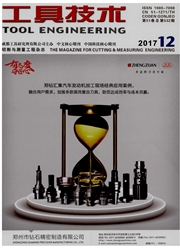

 中文摘要:
中文摘要:
微细产品的需求增大使作为微细产品主要加工方式的微切削受到高度重视。研究微切削过程的变形程度可以预测和控制切削参数,设计高效刀具,提高产品质量。然而微切削过程中的变形剧烈,很难测量。切屑变形系数能够真实反映切削过程中变形且直观易测,研究基于微切削中的切屑变形系数,通过提出的微切削模型描述微切削变形情况;设计正交微车削试验获得微切屑变形系数和切削力,计算第一变形区的剪切角、应变、应力。结果表明正交微切削中的切削厚度(进给量)增大时,切屑变形系数增大;剪切角随进给量增大而增大,用微切削模型得到的剪切角比用宏观切削模型要小:第一变形区的总剪切应变随切削速度的增大而增大,随进给量的减小反而增大;微切削中剪切应力比正应力大,当进给量减小时,应力大致增大,表现出明显的尺度效应。试验证明用切屑变形系数描述微切削中的变形方法简便、有效。
 英文摘要:
英文摘要:
The marked increase in demand for miniaturized components requires understanding deeply of micro-cutting mechanics. Deformation mechanics in micro-cutting plays crucial role on predicting and controlling cutting parameters, designing effective tool and obtaininghigh surface quality. However, the deformation in metal cutting is violent and hard to measure. The chip compression ratio presents plastic deformation and easy to measure. The deformation behaviour is discribed by developed microcutting model from the chip compress ratio. Orthogonal turning experiments were conducted and micro-cutting model was developed to calculate shear angles, shear strain, stresses in micro-cutting. The results show: The chip compress ratio increases when the feed rate increases; The shear angle also increases, but it is lower than in that in macro-cutting. The total shear strain increases when the speed increases, and when the feed rate decreases, the strain increases; The stresses increase when the feed rate decreases and shear stress is larger than the nomal stress . The method is simple and effective to investigate the deformation mechanics in micro- cutting.
 同期刊论文项目
同期刊论文项目
 同项目期刊论文
同项目期刊论文
 期刊信息
期刊信息
